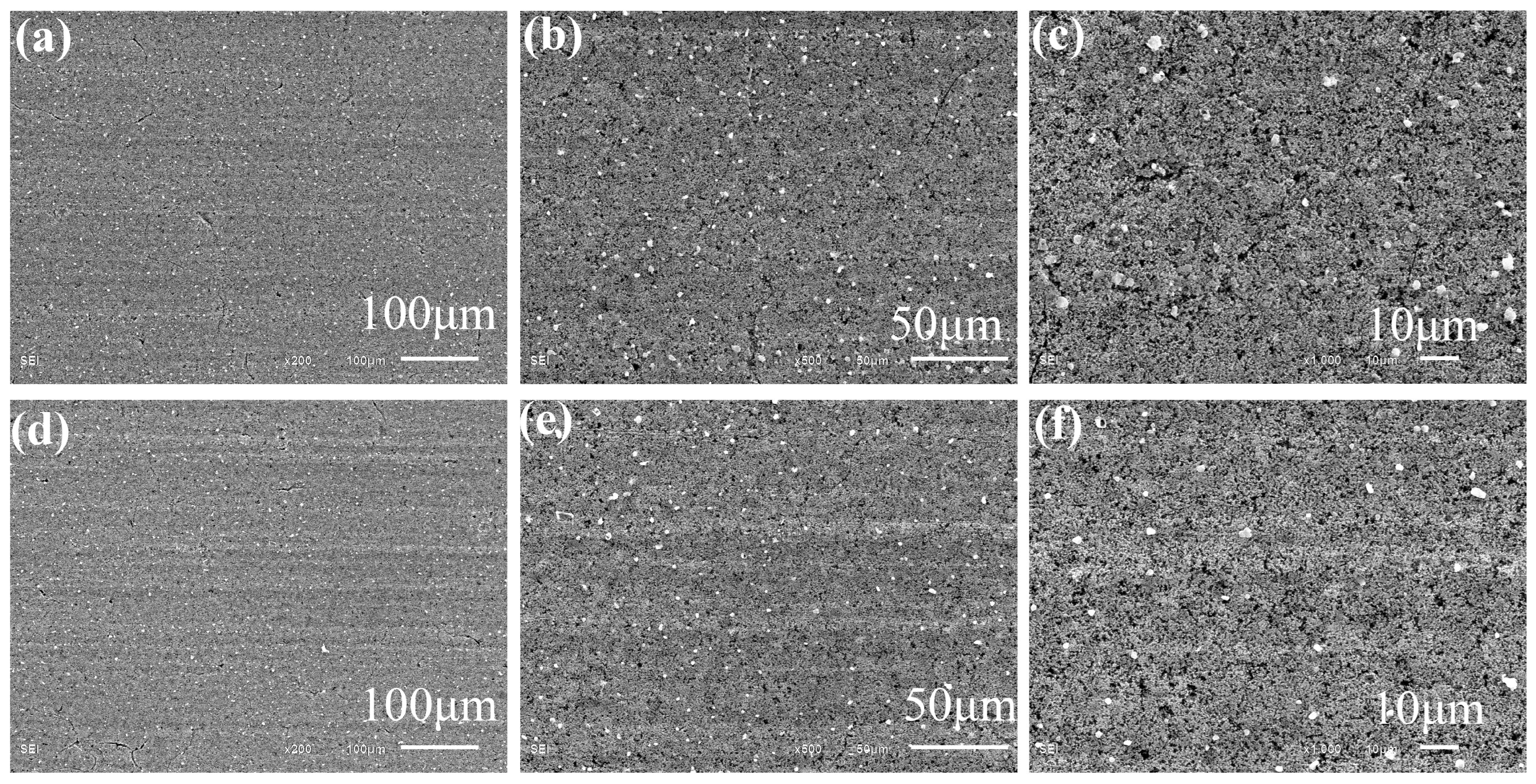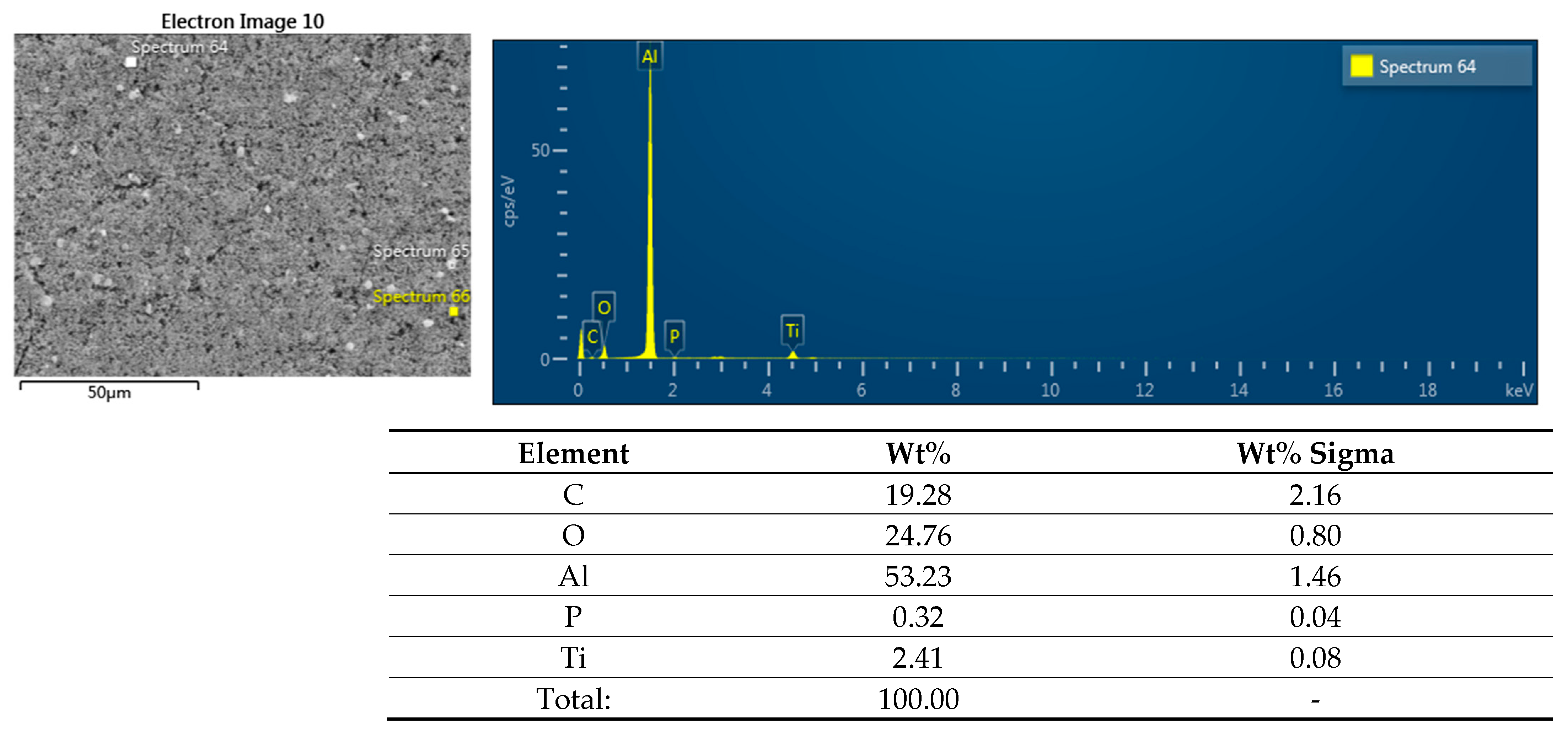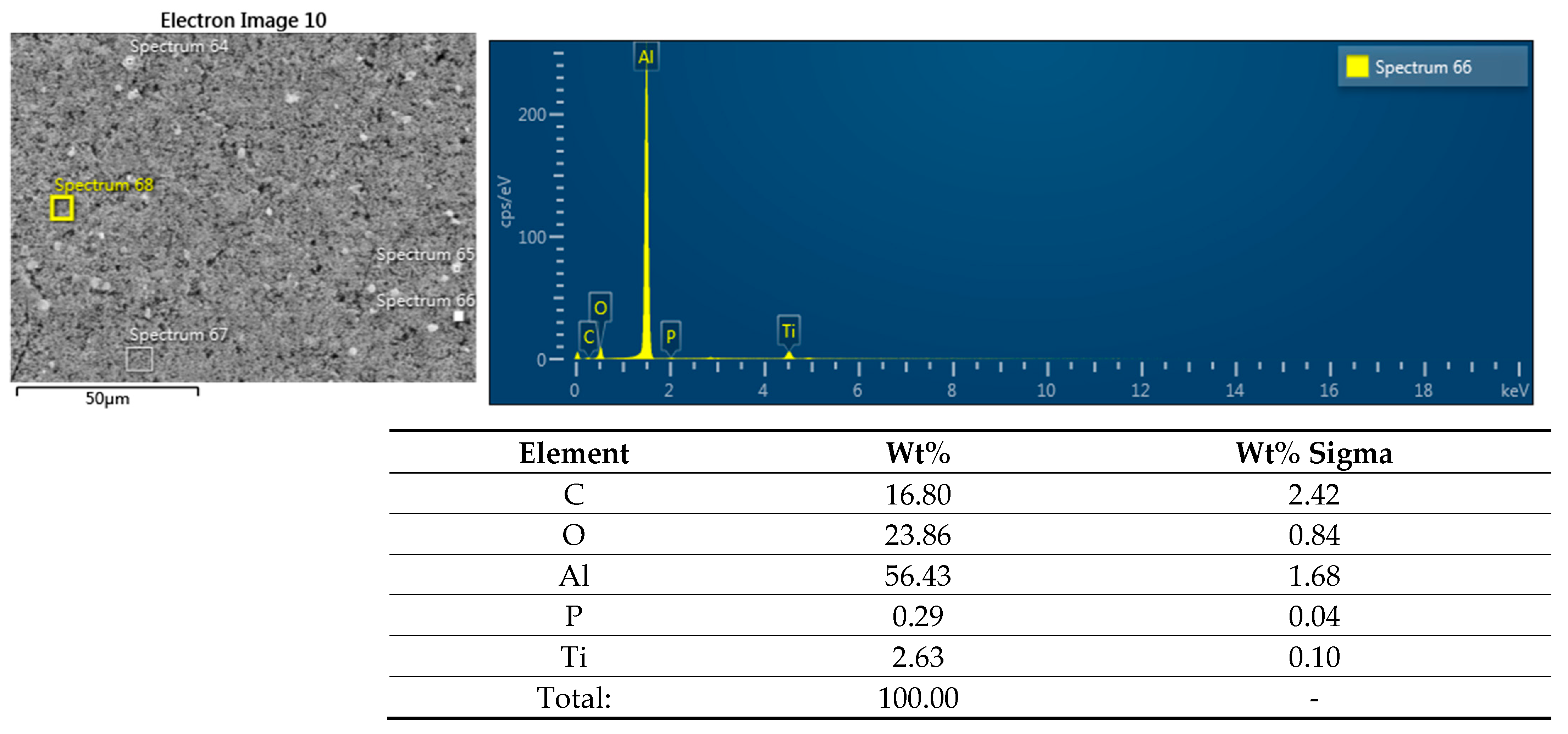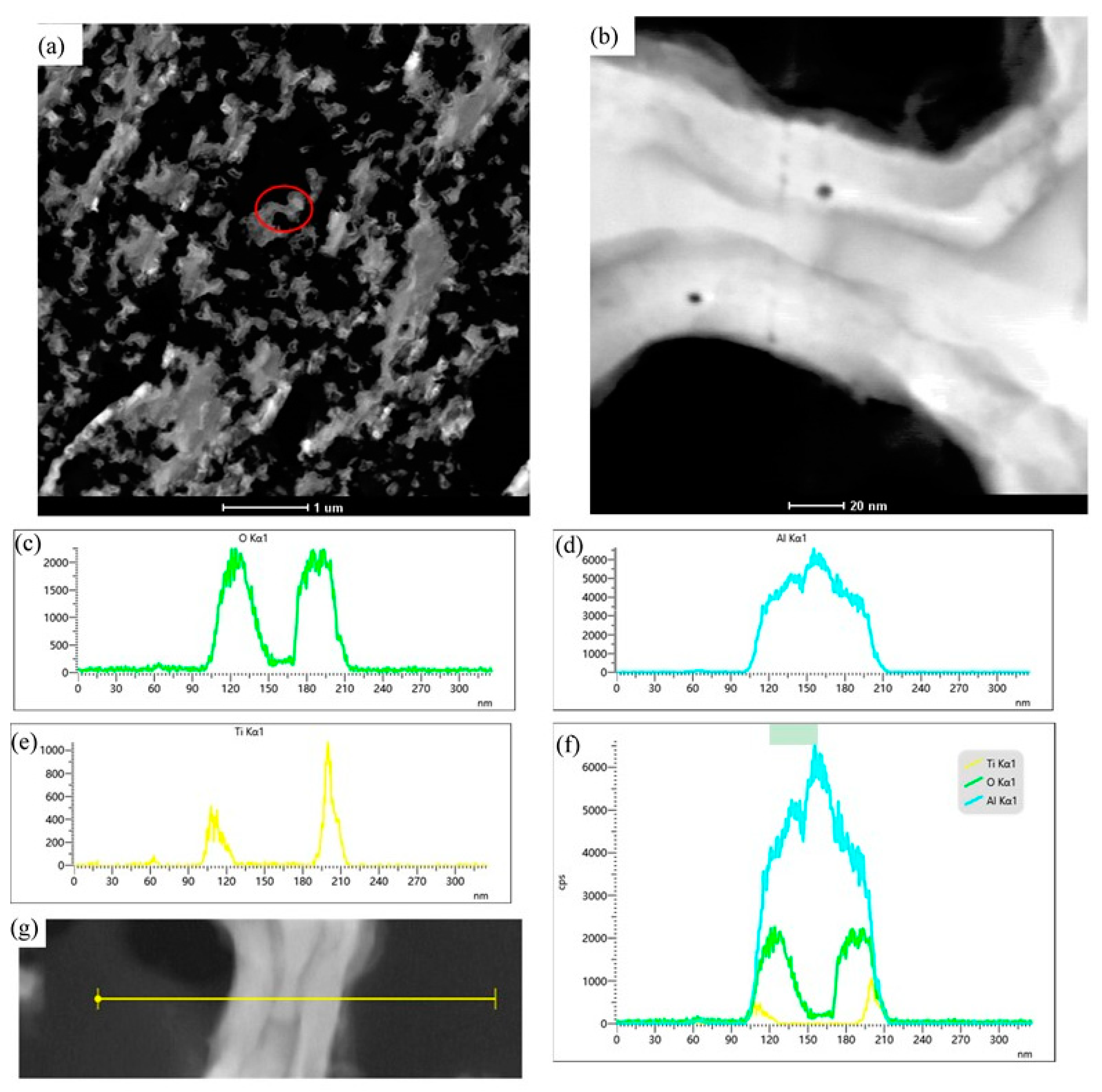Performance and Properties of a Ti-Al Composite Anodic Oxide Film on AC-Etched Al Foil
Abstract
:1. Introduction
2. Experimental Section
2.1. Specimen
2.2. Sol–Gel Coating
2.3. Anodizing
2.4. Micromorphology and Composition of Anodized Samples
2.5. Property and Performance of Anodized Samples
3. Results and Discussion
3.1. Surface SEM Images and EDS of Anodized Samples
3.2. Cross-Section SEM Images and EDS of Anodized Samples
3.3. Cross-Section TEM Images and EDS of Anodized Samples
3.4. Property and Performance of Anodized Samples
3.4.1. Effect of Hydration on Tr, Vt and C25V
3.4.2. Effect of Charging–Discharging on Vt and C25V
3.4.3. EIS of the Anodic Oxide Films
4. Conclusions
Author Contributions
Funding
Informed Consent Statement
Data Availability Statement
Conflicts of Interest
References
- Zhang, K.; Park, S.S. Effects of 2-methyl-1, 3-propanediol in boric acid solution on the anodizing behavior and electrical properties of ZrO2-coated Al foil. Surf. Coat. Technol. 2017, 310, 143. [Google Scholar] [CrossRef]
- Chen, F.; Park, S.S. Formation behavior of multi-layer oxide films on etched al foil by vacuum infiltration and anodization. ECS J. Solid State Sc. 2015, 4, 293. [Google Scholar]
- Watanabe, K.; Sakairi, M.; Takahashi, H.; Hirai, S.; Yamaguchi, S. Formation of Al–Zr composite oxide films on aluminum by sol–gel coating and anodizing. Electroanal. Chem. 1999, 473, 250. [Google Scholar] [CrossRef]
- Ban, C.L.; Liu, Z.Q.; Chen, J.H.; Yin, Y.B.; Zhang, K. Preparation of Nb2O5-Al2O3 Composite Anodic Oxide Film for an Aluminum Electrolytic Capacitor by Electrodeposition-Annealing and Anodization. J. Electron. Mater. 2020, 49, 1051–1058. [Google Scholar]
- Zhang, K.; Park, S.S. Effects of current density on anodizing behavior, micro-structure, and electrical properties of ZrO2-coated Al foils. Appl. Surf. Sci. 2019, 477, 44. [Google Scholar]
- Du, X.; Men, K.; Xu, Y.; Li, B.; Yang, Z.; Liu, Z.; Li, L.; Feng, T.; Rehman, W.; Ullah, I.; et al. Enhanced capacitance performance of Al2O3–TiO2 composite thin film via sol–gel using double chelators. J. Colloid Interface Sci. 2015, 443, 170. [Google Scholar] [PubMed]
- Xiang, L.; Park, S.S. Preparation of titanium dioxide films on etched aluminum foil by vacuum infiltration and anodizing. Appl. Surf. Sci. 2016, 388, 245. [Google Scholar]
- Du, X.F.; Xu, Y.L. Formation of Al2O3–BaTiO3 nanocomposite oxide films on etched aluminum foil by sol–gel coating and anodizing. J. Sol–Gel Sci. Technol. 2008, 45, 57. [Google Scholar]
- Xiang, L.; Park, S.S. Properties of BaTiO3–Al2O3 composite oxide films prepared by sol-gel coating and anodization. Thin Solid Films 2017, 623, 19. [Google Scholar]
- Du, X.F.; Xu, Y.L. Formation of Al2O3–Bi4Ti3O12 nanocomposite oxide films on low-voltage etched aluminum foil by sol–gel processing. Surf. Coat. Tech. 2008, 202, 1923. [Google Scholar]
- Xu, Y.L. Al2O3–(Ba0.5Sr0.5)TiO3 composite oxide films on etched aluminum foil by sol–gel coating and anodizing. Ceram. Int. 2004, 30, 1741. [Google Scholar] [CrossRef]
- Yao, L.; Liu, J.H.; Yu, M.; Li, S.M.; Wu, H.T. Formation and capacitance properties of Ti-Al composite oxide film on aluminum. Nonferr. Metal Soc. 2010, 20, 825. [Google Scholar] [CrossRef]
- Wang, Y.H.; Yang, J.; Wang, J.Z. (Ba0.5Sr0.5)TiO3 modification on etched aluminum foil for electrolytic capacitor. Ceram. Int. 2008, 34, 1285. [Google Scholar] [CrossRef]
- Bu, J.F.; Sun, L.; Wu, Q.; Wang, M.Y.; Lin, C.J. Al2O3-TiO2 composite oxide films on etched aluminum foil fabricated by electrodeposition and anodization. Sci. China Chem. 2011, 54, 1558. [Google Scholar] [CrossRef]
- Park, S.S.; Lee, B.T. Anodizing Properties of High Dielectric Oxide Films Coated on Aluminum by Sol-Gel Method. J. Electroceram. 2004, 13, 111. [Google Scholar] [CrossRef]
- Feng, Z.S.; Chen, J.J.; Zhang, R.; Zhao, N. Formation of Al2O3–Nb2O5 composite oxide films on low-voltage etched aluminum foil by complexation–precipitation and anodizing. Ceram. Int. 2012, 38, 3057. [Google Scholar] [CrossRef]
- Watanabe, K.; Sakairi, M.; Takahashi, H.; Takahiro, K.; Nagata, S.; Hiraic, S. The Electrochemical Society, find out more anodizing of Aluminum Coated with Silicon Oxide by a Sol-Gel Method. J. Electrochem. Soc. 2001, 148, B473. [Google Scholar] [CrossRef]
- Qaisrani, N.A.; Ma, Y.; Ma, L.; Liu, J.; Gao, L.; Li, L.; Gong, S.; Yan, X.; Zhang, F.; He, G. Facile and green fabrication of polybenzoxazine-based composite anion-exchange membranes with a self-cross-linked structure. Ionics 2018, 3053, 24. [Google Scholar] [CrossRef]
- Brudzisz, A.M.; Giziński, D.; Stępniowski, W.J. Incorporation of Ions into Nanostructured Anodic Oxides—Mechanism and Functionalities. Molecules 2021, 6378, 26. [Google Scholar] [CrossRef] [PubMed]
- Wu, J.; Wu, H.; Wu, L.; Yao, W.; Chen, Y.; Sun, L.; Ma, Y.; Jiang, B.; Wang, J.; Atrens, A.; et al. Preparation technology and properties of a thin anodic oxide composite film on the surface of an aluminum alloy foil. Surface Coat. Tech. 2022, 128825, 447. [Google Scholar] [CrossRef]












| Oxide | Al2O3 | ZrO2 | Ta2O5 | Nb2O5 | TiO2 | BaTiO3 | SrTiO3 |
|---|---|---|---|---|---|---|---|
| εr | 9.8 | 22~25 | 27.6 | 41.4 | 90.0 | 500~6000 | >200,000 |
| Area EDS of Sample with Al-Ti Composite Oxide Film | Area EDS of Sample with Blank Oxide Film | ||||
|---|---|---|---|---|---|
| Element | wt% | wt% Sigma | Element | wt% | wt% Sigma |
| C | 13.48 | 2.51 | C | 14.42 | 1.28 |
| O | 29.10 | 0.96 | O | 12.72 | 0.27 |
| Al | 54.55 | 1.62 | Al | 72.48 | 1.10 |
| P | 0.29 | 0.04 | P | 0.38 | 0.02 |
| Ti | 2.58 | 0.09 | Ti | - | - |
| Total | 100 | - | Total | 100 | - |
| Samples | Tr (sec) | Vt (V) | C25V (μF/cm2) | ||||
|---|---|---|---|---|---|---|---|
| Blank | 1 | 49 | Mean Value 46 | 25.7 | Mean Value 25.7 | 109.01 | Mean Value 109.19 |
| 2 | 47 | 25.6 | 110.25 | ||||
| 3 | 42 | 25.8 | 108.31 | ||||
| Composite | 1 | 67 | Mean Value 66.7 | 25.5 | Mean Value 25.5 | 120.21 | Mean Value 120.2 |
| 2 | 67 | 25.5 | 120.29 | ||||
| 3 | 66 | 25.5 | 120.11 | ||||
| Samples | Tr-1h (s) | Vt-1h (V) | C25V-1h (μF/cm2) | ||||
|---|---|---|---|---|---|---|---|
| Blank | 1 | 26 | Mean value 27.7 | 25.4 | Mean value 25.4 | 109.32 | Mean value 109.7 |
| 2 | 30 | 25.3 | 110.87 | ||||
| 3 | 27 | 25.4 | 108.96 | ||||
| Composite | 1 | 34 | Mean value 35.3 | 25.2 | Mean value 25.2 | 120.86 | Mean value 120.7 |
| 2 | 36 | 25.2 | 120.76 | ||||
| 3 | 36 | 25.2 | 120.71 | ||||
| Samples | Tr-24h (s) | Vt-24h (V) | C25V-24h (μF/cm2) | ||||
|---|---|---|---|---|---|---|---|
| Blank | 1 | 27 | Mean Value 26 | 25.2 | Mean Value 25.23 | 110.03 | Mean Value 110.32 |
| 2 | 26 | 25.2 | 111.99 | ||||
| 3 | 25 | 25.3 | 108.95 | ||||
| Composite | 1 | 88 | Mean Value 89.3 | 24.9 | Mean Value 24.93 | 122.24 | Mean Value 121.8 |
| 2 | 90 | 24.9 | 121.95 | ||||
| 3 | 90 | 25.0 | 121.22 | ||||
| Samples | Vt-10,000 (V) | C25V-10,000 (μF/cm2) | Vt-23,000 (V) | C25V-23,000 (μF/cm2) | |||||
|---|---|---|---|---|---|---|---|---|---|
| Blank | 1 | 25.88 | Mean Value 25.97 | 109.47 | Mean Value 109.25 | 24.81 | Mean Value 25.41 | 109.1 | Mean Value 109.04 |
| 2 | 25.91 | 109.55 | 24.76 | 109.19 | |||||
| 3 | 26.06 | 108.78 | 26.02 | 108.75 | |||||
| 4 | 26.01 | 109.21 | 26.05 | 109.13 | |||||
| Composite | 1 | 24.61 | Mean Value 24.84 | 120.86 | Mean Value 121.19 | 24.54 | Mean Value 24.81 | 121.82 | Mean Value 121.17 |
| 2 | 24.6 | 120.76 | 24.56 | 121.82 | |||||
| 3 | 25.33 | 120.71 | 25.32 | 119.89 | |||||
| Specimen | Rox (MΩ·cm−2) | Cox (μF·cm−2) | Rs (Ω·cm−2) | C25V (µF·cm−2) | Vt (V) | Tr (s) |
|---|---|---|---|---|---|---|
| Blank Film | 1.847 | 34.68 | 1.512 | 109.19 | 25.7 | 46 |
| Al-Ti Composite Film | 1.115 | 52.08 | 1.166 | 120.2 | 25.5 | 66.7 |
Disclaimer/Publisher’s Note: The statements, opinions and data contained in all publications are solely those of the individual author(s) and contributor(s) and not of MDPI and/or the editor(s). MDPI and/or the editor(s) disclaim responsibility for any injury to people or property resulting from any ideas, methods, instructions or products referred to in the content. |
© 2023 by the authors. Licensee MDPI, Basel, Switzerland. This article is an open access article distributed under the terms and conditions of the Creative Commons Attribution (CC BY) license (https://creativecommons.org/licenses/by/4.0/).
Share and Cite
Ban, C.; Luo, X.; Sun, J.; Wu, Q.; Yin, Y. Performance and Properties of a Ti-Al Composite Anodic Oxide Film on AC-Etched Al Foil. Coatings 2023, 13, 1526. https://doi.org/10.3390/coatings13091526
Ban C, Luo X, Sun J, Wu Q, Yin Y. Performance and Properties of a Ti-Al Composite Anodic Oxide Film on AC-Etched Al Foil. Coatings. 2023; 13(9):1526. https://doi.org/10.3390/coatings13091526
Chicago/Turabian StyleBan, Chaolei, Xiangjun Luo, Jinchao Sun, Qingxu Wu, and Yibin Yin. 2023. "Performance and Properties of a Ti-Al Composite Anodic Oxide Film on AC-Etched Al Foil" Coatings 13, no. 9: 1526. https://doi.org/10.3390/coatings13091526




